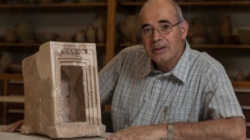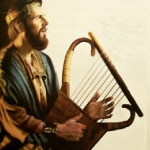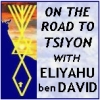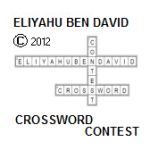|
Visit our website to hear this program free! |
|
|

|
Subscribe to podcast. |
|
"Out of Tsiyon,
the perfection of beauty,
God shines forth"
Psalm 50:2 |
Tsiyon News |
|
 |
June's EBD Crossword Contest
A new crossword
puzzle will be posted this weekend on my website blog at
eliyahubendavid.com. The winner of May's contest will be
announced at that time, and in our next Tsiyon News. Are you the
winner? :-)
Earliest Hebrew
Inscription
Confirms David's Kingdom
3,000-year-old
Artifacts
Confirm David's Kingdom
Condensed from:
THE TIMES OF ISRAEL

Two rare
3,000-year-old models of ancient shrines were among artifacts
presented by an Israeli arch-aeologist in May, 2012 as finds he said
offered new support for the historical veracity of the Bible.
The archaeologist, Yosef Garfinkel of Hebrew Uni-versity, is excavating a
site known as Hirbet Qeiyafa, located in the Judean hills not
far from the modern-day city of Beit Shemesh.
Garfinkel says the central finds presented at a Jerusalem press
conference — two model shrines, one of clay and one of stone — echo
elements of Temple architecture as described in the Bible and
strengthen his claim that the city that stood at the site 3,000
years ago was inhabited by Israelites and was part of the kingdom
ruled from Jerusalem by the biblical King David.
Since Qeiyafa was first unveiled in 2008, it has become
considered one of the most important ongoing excavations in the
world of biblical archaeology. Garfinkel says the existence of a
fortified city at the site around 1,000 BCE supports the idea that a
centralized kingdom existed around that time, as described in the
Bible.
Archaeologists are split over whether King David was a historical
figure, a point of dispute that reflects a broader debate over
whether the Bible is an accurate record of events. Some scholars
believe the text is just that, while others believe it is largely
mythical, based perhaps on fragments of fact.
Garfinkel is firmly in the former camp, and sees his finds at the
site as supporting the idea that the Bible’s account is factually
based.
“There is an argument here that is bigger than the dating of any
one site,” Garfinkel said at the press conference. “In essence, the
whole Bible is being judged.”
 Model shrines of the type found at the site would have been used in
ritual practice. One of the models, 8 inches high, is made of clay,
and includes a main door and two pillars as well as decorative
elements like two lions on the doorstep and three birds perched on
the roof. Garfinkel suggested the pillars were suggestive of the
ones known as Boaz and Yachin, which the Bible says existed in
Solomon’s Temple.
Model shrines of the type found at the site would have been used in
ritual practice. One of the models, 8 inches high, is made of clay,
and includes a main door and two pillars as well as decorative
elements like two lions on the doorstep and three birds perched on
the roof. Garfinkel suggested the pillars were suggestive of the
ones known as Boaz and Yachin, which the Bible says existed in
Solomon’s Temple.
The other shrine, made of limestone and standing 14 inches high,
includes stylized roof beams and a recessed doorway, which Garfinkel
said could help settle disputes about how best to translate some of
the Hebrew words used in the Bible to describe architectural
elements of the Temple.
Perhaps the most notable aspect of the Qeiyafa finds, he said, is
not what has been found but what has not: The diggers have found
none of the cultic figurines of animals or people common at other
sites, he said, suggesting residents followed a prohibition against
idol worship. And the archaeologists at the site have found
thousands of bones of sheep, goats and cattle, but none of pigs,
suggesting they followed a dietary prohibition on swine.



 Model shrines of the type found at the site would have been used in
ritual practice. One of the models, 8 inches high, is made of clay,
and includes a main door and two pillars as well as decorative
elements like two lions on the doorstep and three birds perched on
the roof. Garfinkel suggested the pillars were suggestive of the
ones known as Boaz and Yachin, which the Bible says existed in
Solomon’s Temple.
Model shrines of the type found at the site would have been used in
ritual practice. One of the models, 8 inches high, is made of clay,
and includes a main door and two pillars as well as decorative
elements like two lions on the doorstep and three birds perched on
the roof. Garfinkel suggested the pillars were suggestive of the
ones known as Boaz and Yachin, which the Bible says existed in
Solomon’s Temple.



